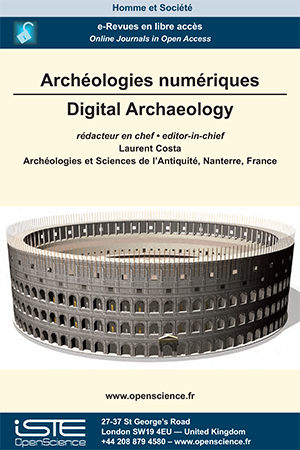

Social Sciences and Humanities > Home > Digital Archaeology > Issue
As part of the Tunisian-Italian archaeological joint mission to the Sahara, a research project (survey and excavation) has focused since 2015 on the study of the funerary archaeology of the prehistoric and historical communities of southern Tunisia. The surveyed area, located along the southern and eastern edges of Chott el Jerid (governorate of Kebili), was selected, after scrutinizing the information collected by the “Service Géographique de l’Armée Française” during the early 20th century about the funerary structures. In this paper, we present two main archaeological funerary contexts and the methodology applied for the photogrammetric documentation of the architectural features of the structures. Then we present the post-processing of the point clouds carried out to obtain a complete data-set for the remote analysis of the excavation sequence of each tumulus. By adopting a multi-scalar approach, from GIS remote analysis to photogrammetric documentation of individual funerary structures, we have tried to optimize the chances of fieldwork activity, taking into consideration whilst so doing the contingencies due to the fluctuating socio-political situation that characterizes some countries of North Africa in recent years.
The acquisition, in 2015, of a high-resolution LiDAR (Light Detection and RAnging) elevation model for the entire geological complex of the Malpaís of Zacapu, West Mexico, has deeply influenced the research methods and general approach to this region of Mesoamerica in recent years. Similar experiments have been conducted in the Pátzcuaro Basin or in the Mayan area, where LiDAR data have also left archaeologists facing methodological and paradigmatic changes: the modus operandi of archaeological work, particularly the field component, has been transformed. Besides the difference in the general research process, the large volume of data available forms a challenge in terms of storage, data management and analysis processes. Specific and adapted strategies and tools thus have to be designed and developed. Finally, tests and retro-analyses have to be run to validate the use of LiDAR data and associated tools in archaeological research. In this article, we focus on two topics, using the case study of the archaeological site of El Infiernillo: first, we present and discuss the potential of methods based on collective “big” data processing (in particular webGIS); and second we test the validity of remotely mapped information by comparing it to data obtained using traditional ground survey methods.
This article aims at describing “Artefacts, online collaborative encyclopaedia of archaeological small finds”, which tries to list all the forms of objects attested between the end of the Prehistory and the pre-industrial period in Europe and around the Mediterranean. It successively discusses the principles of the project, the history of its development as well as the general architecture of the website. The target audience and its respective practices of this collaborative project, in particular, are then evoked as well as the features specifically intended for researchers.
The use of multi-agent simulation (MAS), which were engaged as an exploration, aims to simulate potential theoretical paths of siliceous rock fragments, according to a gravity model and altimetry data from various IGN altitude databases. The objective is to identify areas where eroded siliceous rock fragments may have be concentrated. The aim is therefore to target prospecting activities on these theoretical zones to have the best chance of finding concentrations of these rock fragments. This approach is part of the work of several on going Projets Collectifs de Recherche (PCR) "Réseaux de lithothèques". One of the working axes of these projects is to improve the spatial knowledge of flint formations whose prehistoric populations were able to extract resources for their needs. Main principles of SMA and first results, obtained using NetLogo software and a gravity model, are presented and discussed.

2020
Volume 20- 4
Issue 12019
Volume 19- 3
Issue 1 Proceedings of the session n° III-3 (CA) of the XVIII° UISPP congress, Paris, June 2018 Session III-3 (CA). Construire des référentiels partagés : Webmapping et archéologie.2018
Volume 18- 2
Issue 12017
Volume 17- 1
Issue 1